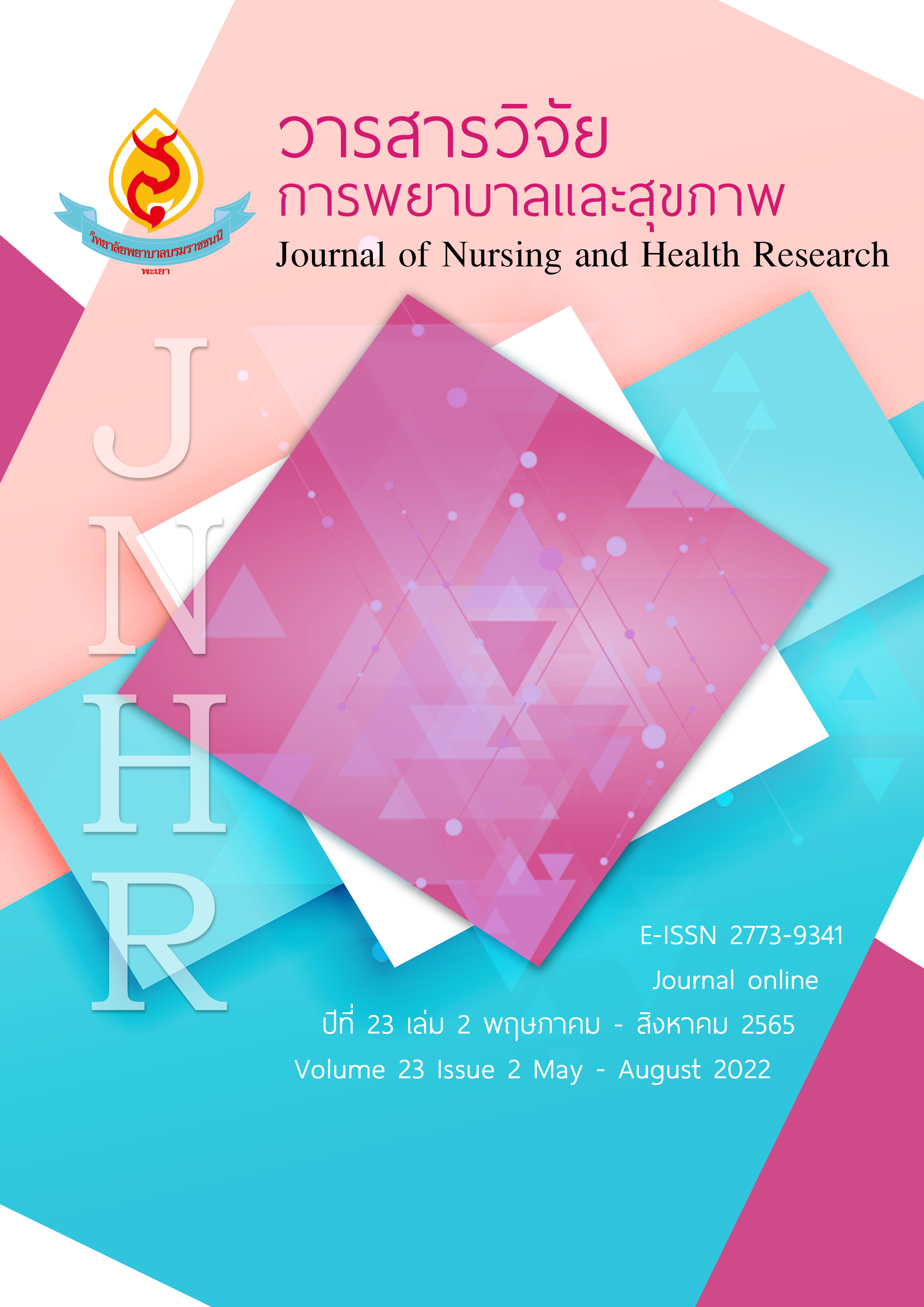ความรอบรู้ด้านสุขภาพตามหลัก 3อ.2ส. และการยึดมั่นในพฤติกรรมป้องกันโรคของบุคคล ที่มีภาวะเสี่ยงสูงต่อโรคความดันโลหิตสูง
คำสำคัญ:
ความรอบรู้ด้านสุขภาพ, การยึดมั่นในพฤติกรรมป้องกันโรค , กลุ่มเสี่ยงสูงต่อโรคความดันโลหิตสูง , อาหาร, ออกกำลังกาย , อารมณ์, งดสูบบุหรี่ , งดดื่มสุรา, 3อ.2ส.บทคัดย่อ
ความรอบรู้ด้านสุขภาพมีความสำคัญต่อผลลัพธ์และการลงทุนด้านสุขภาพ อย่างไรก็ตามการศึกษาความสัมพันธ์ของความรอบรู้ด้านสุขภาพและพฤติกรรมป้องกันโรคในบุคคลที่มีภาวะเสี่ยงสูงต่อโรคความดันโลหิตสูงยังมีจำกัด วัตถุประสงค์การวิจัย 1) เพื่อศึกษาความรอบรู้ด้านสุขภาพตามหลัก 3อ.2ส. ของบุคคลที่มีภาวะเสี่ยงสูง ต่อโรคความดันโลหิตสูง และ 2) เพื่อศึกษาความสัมพันธ์ระหว่างความรอบรู้ด้านสุขภาพตามหลัก 3อ.2ส. และการยึดมั่น
ในพฤติกรรมป้องกันโรคของบุคคลที่มีภาวะเสี่ยงสูงต่อโรคความดันโลหิตสูง การศึกษาภาคตัดขวาง ครั้งนี้ ดำเนินการเก็บข้อมูลระหว่างวันที่ 1 กุมภาพันธ์-30 มีนาคม พ.ศ. 2564 ในกลุ่มตัวอย่างที่มีอายุ 35-59 ปี จำนวน 220 คน
อาศัยอยู่ในอำเภอสิงหนคร จังหวัด สงขลา ได้รับการวินิจฉัยโดยบุคลากรทางการแพทย์ ว่ามีระดับความดันโลหิต
ในเกณฑ์เกือบสูง เครื่องมือวิจัยประกอบด้วย 1) แบบวัดความรอบรู้ด้านสุขภาพและพฤติกรรมสุขภาพ ตาม 3อ.2ส และ 2) แบบวัดการยึดมั่นในพฤติกรรมป้องกันโรคความดันโลหิตสูง ทดสอบความเชื่อมั่นด้วยค่าสัมประสิทธิ์สหสัมพันธ์แอลฟ่าครอนบาค เท่ากับ .83 และ .95 ตามลำดับ ข้อมูลทั่วไปวิเคราะห์ด้วยสถิติบรรยาย วิเคราะห์ความสัมพันธ์ระหว่างความรอบรู้ด้านสุขภาพตามหลัก 3อ.2ส. และการยึดมั่นในพฤติกรรมป้องกันโรค โดยใช้
สถิติ สัมประสิทธิ์สหสัมพันธ์แบบสเปียร์แมน ระดับนัยสำคัญที่ .05 ผลการศึกษา พบว่า 1. บุคคลที่มีภาวะเสี่ยงสูง
ต่อโรคความดันโลหิตสูง มีคะแนนระดับความรอบรู้ด้านสุขภาพโดยรวมอยู่ในระดับพอใช้ มีค่าเฉลี่ย (=47.14, SD=5.50) 2. บุคคลที่มีภาวะเสี่ยงสูงต่อโรคความดันโลหิตสูง มีคะแนนเฉลี่ยการยึดมั่นในพฤติกรรมป้องกันโรค
อยู่ในระดับพอใช้ (=216.04, SD=41.79) 3. ความรอบรู้ด้านสุขภาพตามหลัก 3อ.2ส. โดยรวมมีความสัมพันธ์ทางบวกกับการยึดมั่นในพฤติกรรมป้องกันโรคความดันโลหิตสูง อย่างมีนัยสำคัญทางสถิติ (r=.386, p<.01)
ผลการศึกษาครั้งนี้ควรสนับสนุนความรอบรู้ด้านสุขภาพตามหลัก 3อ.2ส. ที่สัมพันธ์กับการยึดมั่นในพฤติกรรมป้องกันโรคในกลุ่มเสี่ยงสูงต่อโรคความดันโลหิตสูง และส่งเสริมการพัฒนาความรอบรู้ด้านสุขภาพตามหลัก 3อ.2ส. ในกลุ่มเสี่ยงสูงต่อโรคความดันโลหิตสูง เพื่อให้เกิดการยึดมั่นในพฤติกรรมป้องกันโรคความดันโลหิตสูงอย่างจริงจังและต่อเนื่อง
เอกสารอ้างอิง
กองสุขศึกษา กรมสนับสนุนบริการสุขภาพ และมหาวิทยาลัยศรีนครินทรวิโรฒ. (2556). คู่มือการประเมินความรอบรู้ด้านสุขภาพคนไทยอายุ 15 ปี ขึ้นไปในการปฏิบัติตามหลัก 3อ.2ส. นนทบุรี: โรงพิมพ์การเกษตรแห่งประเทศไทย จำกัด.
กองสุขศึกษา กรมสนับสนุนบริการสุขภาพ กระทรวงสาธารณสุข. (2561). แบบประเมินความรอบรู้ด้านสุขภาพและพฤติกรรมสุขภาพ 3อ.2ส. ประชาชนที่มีอายุ 15 ปีขึ้นไป. สืบค้นเมื่อ 17 มกราคม 2564, จาก https://www.nkp-hospital.go.th/th/H.ed/mFile/20180627124613.pdf
คลังข้อมูลสุขภาพด้านการแพทย์ กระทรวงสาธารณสุข. (2564). รายงานตามตัวชี้วัด NCD ClinicPlus ปี 2564. สืบค้นเมื่อ 18 กรกฎาคม 2565, จาก https://hdcservice.moph.go.th/hdc/ reports/report.php?
source=pformated/format1php&cat_id=6966b0664b89805a484d7ac96c6edc48&id=6833128a5d76a6afcae3e4a6af0e718c
Aynalem, G. A., Bekele, T. A., Berhe, T. T., & Endazenew, G. (2021). Factors affecting adherence to lifestyle modification among patients with hypertension at Yekatit 12 Hospital Medical College, Addis Ababa, Ethiopia, 2019. SAGE Open Med, 9, 1-8. doi:10.1177/20503121211012523
Babazadeh, T., Nadrian, H., Ranjbaran, S., Rezakhani-Moghaddam, H., & Aghemiri, M. (2019). Cognitive factors associated with brucellosis preventive behaviors among diagnosed patients: an application of empowerment model. East Mediterr Health J, 25(8), 567–574. doi:10.26719/emhj.18.062
Baker, D. W. (2006). The meaning and the measure of health literacy. J Gen Intern Med, 21(8), 878–883. doi:10.1111/j.15251497.2006.00540.x
Cavaco, A., & Santos, A. L. (2012). Evaluation of health literacy and the readability of information Leaflets. Rev Saude Publica, 46(5), 918–922. doi:10.1590/s0034-89102012000500019
Siriwan Chukumnird, Umaporn Boonyasopun, & Piyanuch Jittanoon. (2016). Perspectives regarding adherence to preventive behaviors : a qualitative study of Thais with prehypertension. Pacific Rim International Journal of Nursing Research, 20(2), 106–118. Retrieved from https://he02.tci-thaijo.org/index.php/PRIJNR/article/view/39867
Siriwan Chukumnird, Umaporn Boonyasophun, & Krittaporn Sirisom. (2018). Factors influencing adherence to preventive behaviors among Thais with hypertension: a literature review. Walailak Journal of Science and Technology (WJST), 16(8), 509–521. doi:10.48048/wjst.2019.3863
Egan, B. M., & Stevens-Fabry, S. (2015). Prehypertension--prevalence, health risks, and management strategies. Nature Reviews Cardiology, 12(5), 289–300. doi:10.1038/nrcardio.2015.17
Froze, S., & Arif, M. (2019). Determinants of health literacy and healthy lifestyle against metabolic syndrome among major ethnic groups of Sarawak, Malaysia: a multi-group path analysis. Open Public Health Journal, 12(1), 172-183.
Gaffari-Fam, S., Babazadeh, T., Oliaei, S., Behboodi, L., & Daemi, A. (2020). Adherence to a health literacy and healthy lifestyle with improved blood pressure control in Iran. Patient Prefer Adherence, 14, 499–506. doi:10.2147/PPA.S244820
Golshahi, J., Ahmadzadeh, H., Sadeghi, M., Mohammadifard, N., & Pourmoghaddas, A. (2015). Effect of self-care education on lifestyle modification, medication adherence and blood pressure in hypertensive adults: randomized controlled clinical trial. Advanced Biomedical Research, 4, 204. doi:10.4103/2277-9175.166140
Guo, J., Lv, J., Guo, Y., Bian, Z., Zheng, B., Wu, M., … China Kadoorie Biobank Collaborative Group (2021). Association between blood pressure categories and cardiovascular disease mortality in China. PloS One, 16(7), e0255373. doi:10.1371/journal.pone.0255373
Hair, J., Anderson, R., Tatham, R., & Black, W. (1998). Multivariate data analysis (5th ed.), Prentice Hall: New Jersey.
Hasandokht, T., Farajzadegan, Z., Siadat, Z. D., Paknahad, Z., & Rajati, F. (2015). Lifestyle interventions for hypertension treatment among Iranian women in primary health-care settings: results of a randomized controlled trial. Journal of Research in Medical Sciences, 20(1), 54–61.
Hinkle, D.E. (1998). Applied Statistic for the Behavioral Sciences. Boston: Houghton Mifflin.
Huang, Y., Cai, X., Zhang, J., Mai, W., Wang, S., Hu, Y., … Xu, D. (2014). Prehypertension and incidence of ESRD: a systematic review and meta-analysis. American Journal of Kidney Diseases, 63(1), 76–83. doi:10.1053/j.ajkd.2013.07.024
Kjeldsen, S. E. (2018). Hypertension and cardiovascular risk: general aspects. Pharmacological Research, 129, 95–99. doi:10.1016/j.phrs.2017.11.003
Loma, V., Tanasugarn, C., Tipayamongkholgul, T., Aimyong, N., Neelapaichit, N., Samnuanklang, M., … Kloyiam, S. (2017). National health literacy survey project for Thai people aged 15 years and above (phase 1). Retrieved July 2, 2022, from http://164.115.27.97/digital/files/original/a6e73814efb58a07991c5be54b1498d1.pf
Miller, T. A. (2016). Health literacy and adherence to medical treatment in chronic and acute illness: a meta-analysis. Patient Education and Counseling, 99(7), 1079–1086. doi:10.1016/j.pec.2016.01.020
Nutbeam, D. (2008). The evolving concept of health literacy. Social science & medicine, 67(12), 2072–2078. https://doi.org/10.1016/j.socscimed.2008.09.050
Rowlands, G., Protheroe, J., Winkley, J., Richardson, M., Seed, P. T., & Rudd, R. (2015). A mismatch between population health literacy and the complexity of health information: an observational study. The British Journal of General Practice: the Journal of the Royal College of General Practitioners, 65(635), e379–e386. doi;10.3399/bjgp15X685285
Rubinelli, S., Schulz, P. J., & Nakamoto, K. (2009). Health literacy beyond knowledge and behavior: letting the patient be a patient. International Journal of Public Health, 54(5), 307–311. https://doi.org/10.1007/s00038-009-0052-8
Wang, M., Wu, T., Yu, C., Gao, W., Lv, J., Wu, Y., … Hu, Y. (2020). Association between blood pressure levels and cardiovascular deaths: a 20-year follow-up study in rural China. BMJ Open, 10(2), e035190.
Whelton, P. K., Carey, R. M., Aronow, W. S., Casey, D. E., Jr, Collins, K. J., Dennison Himmelfarb, C., … Wright, J. T., Jr (2018). 2017 ACC/AHA/AAPA/ABC/ACPM/AGS/APhA/ASH/ASPC/NMA/PCNA Guideline for the Prevention, Detection, Evaluation, and Management of High Blood Pressure in Adults: A Report of the American College of Cardiology/American Heart Association Task Force on Clinical Practice Guidelines. Hypertension (Dallas, Tex. : 1979), 71(6), e13–e115. doi:10.1161/HYP.0000000000000065
Wu, Y., Wang, L., Cai, Z., Bao, L., Ai, P., & Ai, Z. (2017). Prevalence and risk factors of low health literacy: a community-based study in Shanghai, China. International Journal of Environmental Research and Public Health, 14(6), 628. doi:10.3390/ijerph14060628
Zhang, N. J., Terry, A., & McHorney, C. A. (2014). Impact of health literacy on medication adherence: a systematic review and meta-analysis. The Annals of Pharmacotherapy, 48(6), 741–751. https://doi.org/10.1177/1060028014526562
ดาวน์โหลด
เผยแพร่แล้ว
รูปแบบการอ้างอิง
ฉบับ
ประเภทบทความ
สัญญาอนุญาต
ลิขสิทธิ์ (c) 2022 วารสารวิจัยการพยาบาลและสุขภาพ

อนุญาตภายใต้เงื่อนไข Creative Commons Attribution-NonCommercial-NoDerivatives 4.0 International License.



